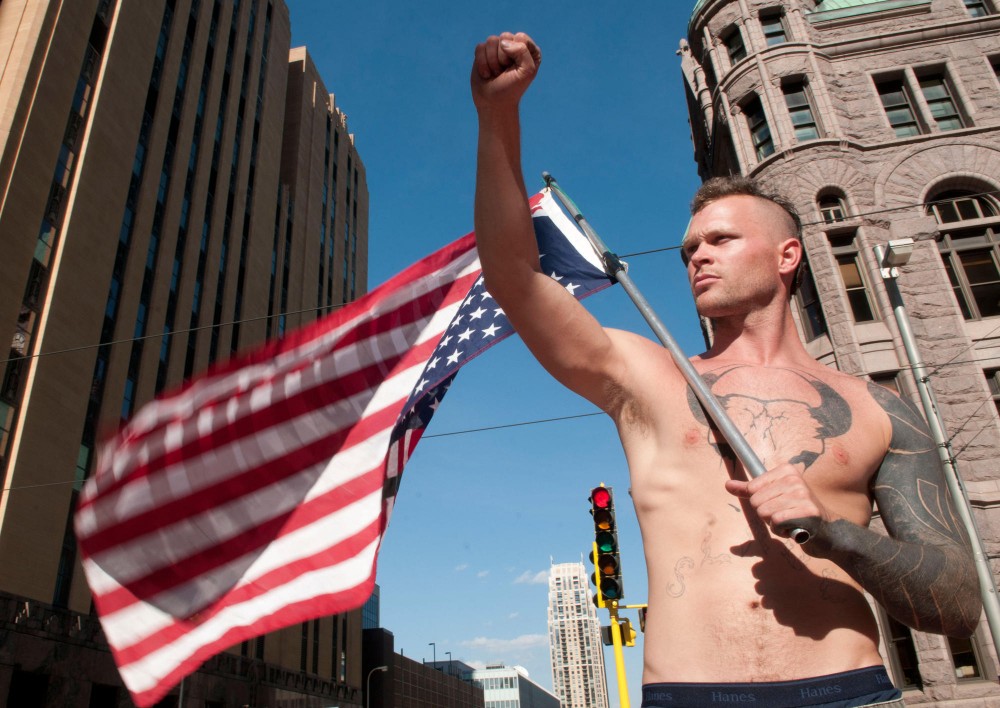It started Sept. 17 with a small demonstration in New York. That protest grew to thousands of people that camped out near the New York Stock Exchange, and its spirit spread to major cities across the nation.
Minnesotans gathered Friday morning in downtown Minneapolis to support the âÄúOccupy Wall StreetâÄù protesters with their own take âÄî Occupy Minnesota.
Unlike the Occupy Wall Street protests, however, the number of demonstrators has substantially dwindled since the protestsâÄô initial momentum.
At its peak on Saturday, the chatter and chants of an estimated 1,000 demonstrators filled the Hennepin County Government Plaza âÄî what protesters have dubbed âÄúThe PeopleâÄôs Plaza.âÄù
The number of overnight occupants decreased from approximately 150 people Friday night to about 80 Saturday night. By Sunday morning, only 50 or so protesters sat in the plaza or lined the surrounding streets with signs.
Despite their shrinking numbers, demonstrator Nora Knutson, 19, said Sunday morning that she and others expect more protesters to return.
From 18-year-old students to middle-aged men and women, demonstrators have flowed in and out of the plaza to show a shared discontent for what they consider a lack of representation by the government.
University of Minnesota senior Ryan Broden said that he went to the plaza on Friday because he felt it was necessary.
âÄúEveryone should be here, unless youâÄôre a billionaire,âÄù Broden said.
He said his grievances were similar to those of the others gathered in the plaza. The problems range from economic inequality to environmental awareness to health care reform, Broden said.
Molly Hanley, a 19-year-old from Minneapolis, joined the protest for a very personal reason. Her father, who suffers from Type I diabetes, recently lost his job and medical insurance.
Hanley said sheâÄôs concerned about how her family will be able to afford his medicine.
âÄúHe needs it for life; he didnâÄôt choose to be a diabetic,âÄù Hanley said.
Though she knows that the Occupy Minnesota protests are not specifically geared toward health care reform, she said she believes strongly that this is a first step toward change.
Occupy Minnesota co-founder and organizer Osha Karow said he felt compelled to join in solidarity with the Wall Street protests. Karow said that these protests are creating a voice for Minnesotans, while also being a part of âÄúa united global community.âÄù
Tony Boicourt bused three hours from the University of Minnesota, Duluth to reach the protests in Minneapolis, and will miss three days of classes.
Boicourt is another founder of the movement that began online with the creation of a website, Facebook and Twitter pages. He never intended to start any protests, he said.
Originally, he and a group of other UMD students wanted to join the protests on Wall Street.
âÄúIf we canâÄôt get to Wall Street,âÄù Boicourt said, âÄúWe can start our own [demonstrations].âÄù
âÄúIâÄôve had it,âÄù said University senior Andrew Rennert. âÄúCorporations have more rights than people.âÄù
Rennert said that local politicians need to see and understand the Occupy Minnesota protests.
Former Minnesota Gov. Jesse Ventura and Congressman Keith Ellison, D-Minn., were among the politicians who came to the plaza to show their support when the protests began Friday.
âÄúPeople are standing up for themselves and for each other,âÄù Ellison said. âÄúThey believe in our country.âÄù
Ellison emphasized the important role that ethnic, racial and religious diversity will play in creating change.
âÄúWe need Americans to stand up,âÄù Ellison said.
Boicourt compared the demonstrations in Minnesota and across the country to 1960s protests.
Occupy Minnesota demonstrations have been cooperating with police from the start. Karow said that he and other organizers met with police before Friday and periodically throughout the weekend to ensure cooperation.
In New York, dozens of protesters were arrested Wednesday as they marched on Wall Street. About 700 people were arrested Oct. 1.
Police officers patrolled around the plaza throughout the weekend, passively watching the crowd. Several officers said there have been no problems.
-The Associated Press contributed to this report








